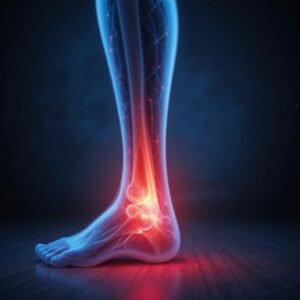Osteoporosis is a common yet often overlooked condition that primarily affects women, especially as they age. It is characterized by a decrease in bone density and strength, making bones more fragile and prone to fractures. This condition is sometimes referred to as a “silent disease” because it progresses without noticeable symptoms until a fracture occurs. Understanding osteoporosis, its causes, symptoms, and ways to prevent and treat it, is crucial for maintaining long-term bone health.
What is Osteoporosis?
Osteoporosis, which literally means “porous bones,” is a condition where the bones lose their density and mass, leading to structural weakness. Healthy bones are dense and strong, but in osteoporosis, the bone tissue deteriorates, leaving the bones brittle and more susceptible to fractures. The most common fracture sites are the hips, spine, and wrists, which can significantly impact mobility and quality of life.
Why Are Women More Prone to Osteoporosis?
Women are at a higher risk of developing osteoporosis compared to men due to several factors:
- Hormonal Changes: Estrogen, a hormone that protects bone density, decreases significantly after menopause. This drop accelerates bone loss, making postmenopausal women particularly vulnerable.
- Smaller Bone Structure: Women generally have smaller and thinner bones than men, which means they have less bone mass to lose as they age.
- Longer Life Expectancy: Women tend to live longer than men, and the risk of osteoporosis increases with age.
- Pregnancy and Breastfeeding: These life stages can temporarily reduce bone density due to the body’s increased demand for calcium.
Risk Factors for Osteoporosis in Women
While aging and menopause are significant contributors, other factors can increase the risk of osteoporosis in women:
- Family History: A family history of osteoporosis or fractures can increase susceptibility.
- Dietary Deficiencies: Low calcium and vitamin D intake can weaken bones over time.
- Sedentary Lifestyle: Lack of weight-bearing exercises can lead to weaker bones.
- Smoking and Alcohol: Both smoking and excessive alcohol consumption negatively affect bone health.
- Certain Medications: Long-term use of corticosteroids or medications for conditions like rheumatoid arthritis can contribute to bone loss.
- Medical Conditions: Disorders such as thyroid imbalances, celiac disease, or eating disorders can also increase the risk.
Symptoms of Osteoporosis
Osteoporosis is often called a “silent disease” because it typically shows no symptoms until a fracture occurs. However, some warning signs may include:
- Back pain caused by a fractured or collapsed vertebra.
- Loss of height over time.
- A stooped posture or “hunched back” (kyphosis).
- Fractures that occur more easily than expected, even from minor falls or injuries.
Diagnosing Osteoporosis
Osteoporosis is diagnosed using a bone density test, also known as a DEXA (dual-energy X-ray absorptiometry) scan. This test measures bone mineral density (BMD) and compares it to the average BMD of a healthy young adult. The results are given as a T-score:
- A T-score of -1.0 or above is normal.
- A T-score between -1.0 and -2.5 indicates low bone mass (osteopenia).
- A T-score of -2.5 or lower confirms osteoporosis.
Preventing Osteoporosis in Women
Prevention is key when it comes to osteoporosis. Women can take proactive steps to maintain strong and healthy bones throughout their lives:
- Adequate Calcium Intake: Women aged 19-50 need about 1,000 mg of calcium daily, while those over 50 require 1,200 mg. Good sources include dairy products, leafy greens, almonds, and fortified foods.
- Vitamin D: Vitamin D helps the body absorb calcium. Sun exposure, fatty fish, and supplements are excellent sources.
- Regular Exercise: Weight-bearing and resistance exercises, such as walking, jogging, yoga, and strength training, are essential for building and maintaining bone density.
- Healthy Lifestyle Choices: Avoid smoking and limit alcohol consumption, as both can weaken bones.
- Bone Health Monitoring: Regular check-ups and bone density tests can help detect early signs of bone loss.
Treatment Options for Osteoporosis
If diagnosed with osteoporosis, several treatment options are available to help manage the condition and reduce the risk of fractures:
- Medications:
- Bisphosphonates: These drugs slow bone loss and include options like alendronate and risedronate.
- Hormone Therapy: Estrogen replacement therapy can help maintain bone density in postmenopausal women, though it may not be suitable for everyone.
- Selective Estrogen Receptor Modulators (SERMs): Medications like raloxifene mimic estrogen’s protective effects on bones.
- Bone-Building Drugs: For severe cases, drugs like teriparatide or romosozumab can stimulate new bone growth.
- Calcium and Vitamin D Supplements: These are often recommended to ensure adequate nutrient intake.
- Lifestyle Modifications: Incorporating a healthy diet, regular exercise, and fall prevention strategies can significantly reduce fracture risk.
Living with Osteoporosis
While osteoporosis can be a challenging condition, it is manageable with the right approach. Women living with osteoporosis should focus on:
- Fall Prevention: Minimize the risk of falls by keeping living spaces clutter-free, using non-slip mats, and wearing supportive footwear.
- Physical Therapy: Working with a physical therapist can improve balance, strength, and posture.
- Support Networks: Joining support groups or seeking counseling can help cope with the emotional impact of living with a chronic condition.
Conclusion
Osteoporosis is a significant health concern for women, particularly as they age. By understanding the risk factors, symptoms, and preventive measures, women can take control of their bone health and reduce the likelihood of fractures. Early diagnosis and treatment are crucial for managing osteoporosis effectively. Whether through lifestyle changes, medications, or a combination of both, women can lead active and fulfilling lives despite this condition. Prioritizing bone health today can ensure a stronger, healthier tomorrow.
